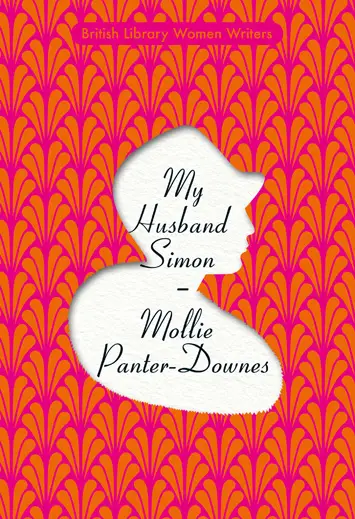My Husband Simon by Mollie Panter-Downes – Review

By Clare Jenkins
I first came across the writer Mollie Panter-Downes in India, in Higginbothams Bookshop in Ootacamund – known in British Raj days as ‘Snooty Ooty’. Browsing through the wide-ranging collection of books – everything from heavy academic texts through business manuals to Agatha Christie’s Murder in the Vicarage – I found Ooty Preserved, her 1967 account of ‘A Victorian Hill Station in India’. It was fascinating.
The book described the last Brits who ‘stayed on’ in Ooty after Indian Independence, and the places where they lived. She found ‘terracotta buildings, Victorian gables and a house with turrets that might be in Wimbledon’. She discovered a road junction called Charing Cross, houses called Kenilworth, Bleak House, Westward Ho! and Lupin Cottage, a social calendar that included races, dog and flower shows, days out hunting on the downs and evenings gossiping at the (still very exclusive) club. It ‘was not India’, she wrote. ‘It was the little patch of England that each exile discovered it to be’.
If all that sounds journalistically observant, that’s because Panter-Downes was a journalist – she wrote 850 or so pieces for The New Yorker magazine. Despite later claiming, “I’m a reporter. I can’t invent”, she was also a novelist and short story writer, who ought to be much better known today than she is.
Thankfully, 20-odd years ago, the excellent Persephone Books began championing her, and are still publishing her ‘wartime’ and ‘peacetime’ stories (Good Evening, Mrs Craven and Minnie’s Room respectively), along with One Fine Day, which they call ‘one of the century’s most enduring novels’. But it’s the British Library who published My Husband Simon two years ago as part of their aim to republish works by early to mid-20th Century female writers. Their Women Writers series, they say, ‘highlights the best middlebrow fiction from the 1910s to the 1960s, offering escapism, popular appeal and plenty of period detail to amuse, surprise and inform’.
My Husband Simon does all of this, and more. First published in 1931 and very deftly written, it tells the story of 24-year-old novelist Nevis Falconer, who falls passionately in love with Simon Quinn, marries him, and then struggles to retain her writing ‘voice’. Nevis is unusual for her time – an intellectual upper-middle-class young woman who lives on her own after her parents have died. She’s looked after by a ‘charwoman’ called Proutie who ‘was like the geyser, temperamental. I couldn’t rely on her, but she was always cheerful and, so far as I could see, didn’t steal the gin’. And Nevis lead a disciplined writing life that still leaves time in the evenings for parties, dinners, dances and clubs.
Simon, middle-middle-class and 28, lacks her cultural awareness, preferring pubs, horse races and lolling about in the City earning a lot of money on the Stock Exchange. He’s tolerant of her writing, but uninterested in it, boasting that ‘I’m practically illiterate’. ‘His idea of real enjoyment’, says Nevis, sardonically clear-eyed, ‘was sitting in a hot, crowded tap-room, talking horses with a drunk navvy who might later try to pick a fight with him’.
The pair are intellectually unsuited, ‘intensely egotistical’, but physically drawn to each other. They fight like cat and dog, but he can always disarm her by being seductive. She despises his family and can be a terrible snob about other people she comes across. And so, for three years, they flow together and apart, while all the time Nevis struggles to complete her second novel after the critical and public success of her first (Panter-Downes herself wrote her first novel at 16). ‘For nearly three years I laboured over the body, and blew upon its cold flesh, and besought it to live. And lo! It was dead. It looked at me with glazed eyes. It drew not a single honest breath of life in all its 350 pages’.
“Explores the many other nuances of class”
 Then her American publisher, Marcus Chard, arrives in London. Far from being tall, dark and handsome (a romantic fiction cliché), Chard is instead ‘about Simon’s height, but much broader, enormous shoulders and a thick bull neck’. That very difference from the handsome, lithe and blonde Simon is what attracts her. They talk about novels, culture, London’s literary life and New York – things she can’t talk about with her husband. And she feels her passion for writing resurfacing, battling even more with her passion for Simon.
Then her American publisher, Marcus Chard, arrives in London. Far from being tall, dark and handsome (a romantic fiction cliché), Chard is instead ‘about Simon’s height, but much broader, enormous shoulders and a thick bull neck’. That very difference from the handsome, lithe and blonde Simon is what attracts her. They talk about novels, culture, London’s literary life and New York – things she can’t talk about with her husband. And she feels her passion for writing resurfacing, battling even more with her passion for Simon.
It’s obvious to the reader (and to Simon) that Chard is falling in love with Nevis, but it takes her rather longer to figure out. Then she is faced with a choice: to go back to America with him, stay in an apartment he owns (while he stays in a hotel – he says), and write the follow-up to her novel; or stay in England with Simon, have a baby, give up the literary struggle, and morph into just another Quinn.
Like Virginia Woolf’s A Room of Her Own, this novel addresses the struggles faced by creative women – on the one hand, their desire to paint, write, compose music; on the other, the pull of love, family life, domesticity. Woolf argued that women must have money and a room of their own in which to create. Nevis Falconer has both those things, yet is still being sucked wordless by society’s expectations of a married woman.
Far from preaching, however, My Husband Simon approaches its theme with a lightness of touch and a sense of wry humour that engages from the start. She first meets Simon at a weekend house party at her best friend Cora’s. ‘Cora had a funny, breathless way of speaking, as though she could not trust her attractive husky voice to hold out for long… She was thirty-five, ugly in a fascinating way, with no colour at all in her small face or her beautiful cendré [ash-blonde] hair, which was uncut, swathed tightly in a turban round her head. Her ankles were lovely. Chanel dressed her. She had three ugly cendré children and was supposed to love Frank Fenton, which I thought distinctly unenterprising’.
Simon himself ‘had curiously light eyes with dusty gold lashes. I thought, “He’s attractive.” I felt suddenly angry and helpless, as though I knew that the nice, orderly little pattern of my life was going to be broken up’.
And so it proves. Nevis has the wealth and confidence to ignore the quiet disapproval of her in-laws, who wonder why she doesn’t just start a family, like her sister-in-law Gwen. Nevis (whose grandmother has a title) says: ‘The phrase “a Quinn” had come to symbolise a whole class of society in my mind… London was full of Quinns, eating saddle of mutton at handsome mahogany tables; going up steps of good clubs and stepping out of quiet, expensive cars; thinking that “art” meant the Royal Academy, and “beauty” was the sort of wishy-washy, rubber-stamp, damnable prettiness that you see on the lid of a chocolate box’.
Such snobbery can grate, but the whole novel explores the many other nuances of class – the way people dress, speak, eat, the work they do (or don’t do), the way they relate to others. Nevis’s servants, for instance, prefer Simon’s rudeness to her awkward politeness. Yet, despite telling herself that she treats them like human beings, she subsequently likens one to more like ‘an ignorant animal who was perhaps slightly more valuable than a cow’.
Overall, though, My Husband Simon is a fine novel, discerningly – sometimes waspishly – exploring the tensions within a marriage. Her descriptions of 1930s London are both delicate and detailed, and she almost forensically dissects the English class system of the time and the American ability to cut through it. Yes, it’s set 90 years ago, and yes, it’s about a very entitled existence, but it still feels fresh and still says much that is accurate and relevant today – including about the power invested by wealth and privilege.
‘My Husband Simon’ by Mollie Panter-Downes is published by The British Library, £9.99 paperback









